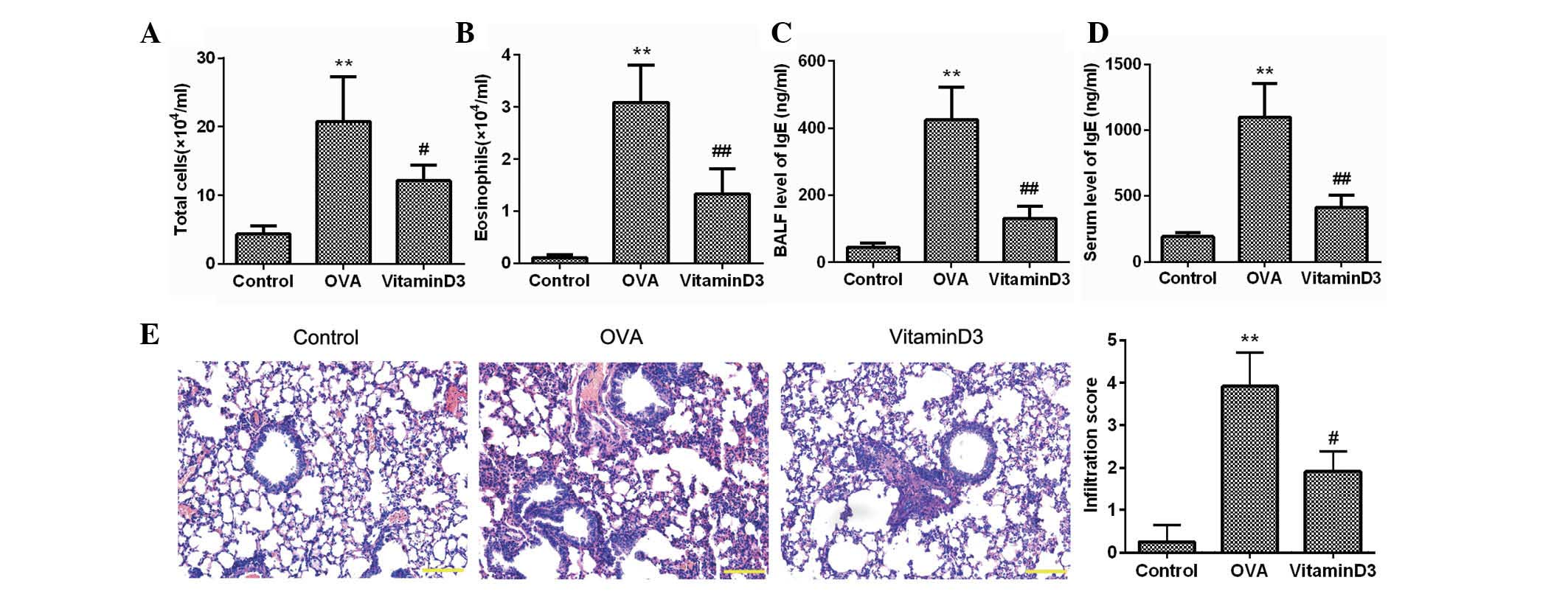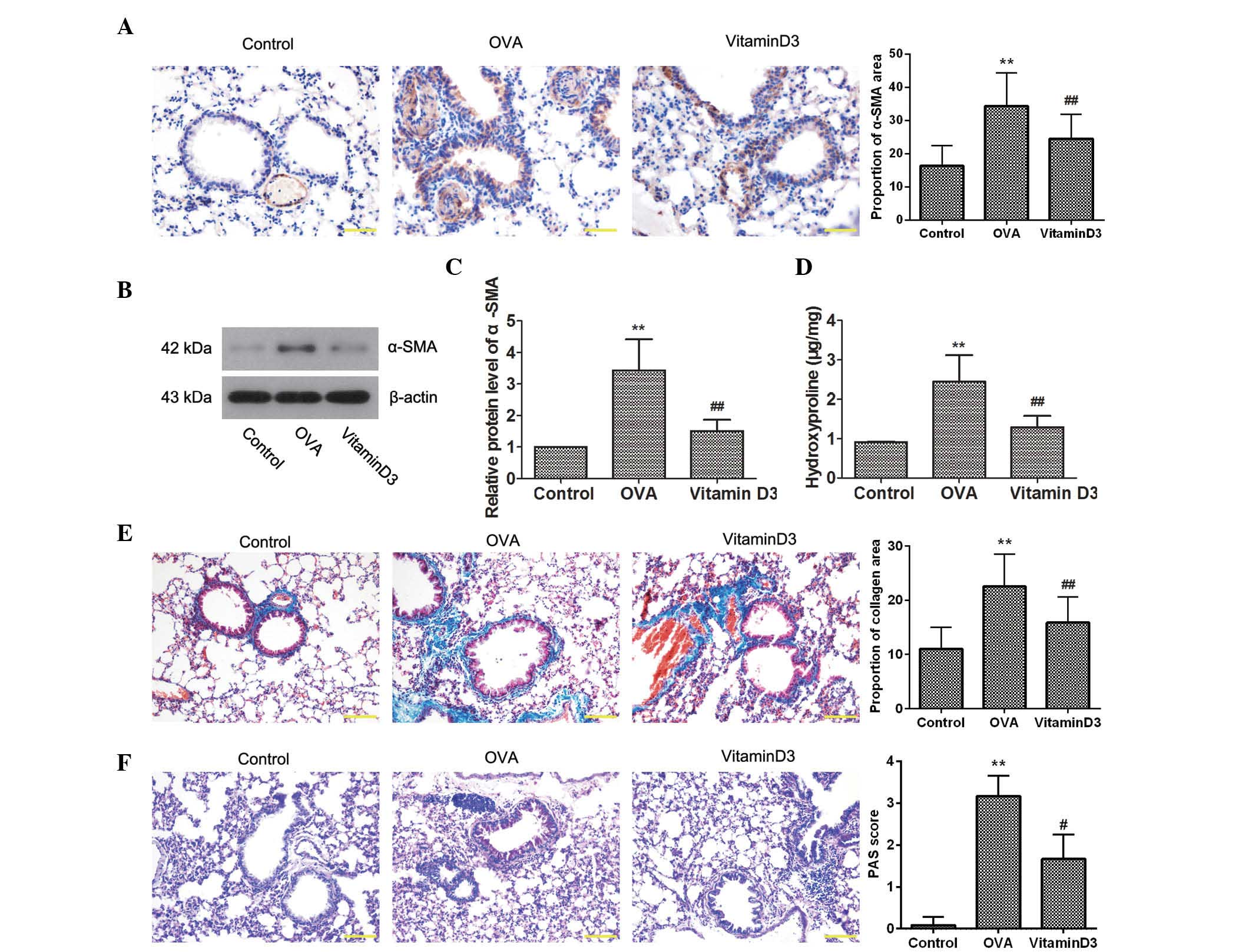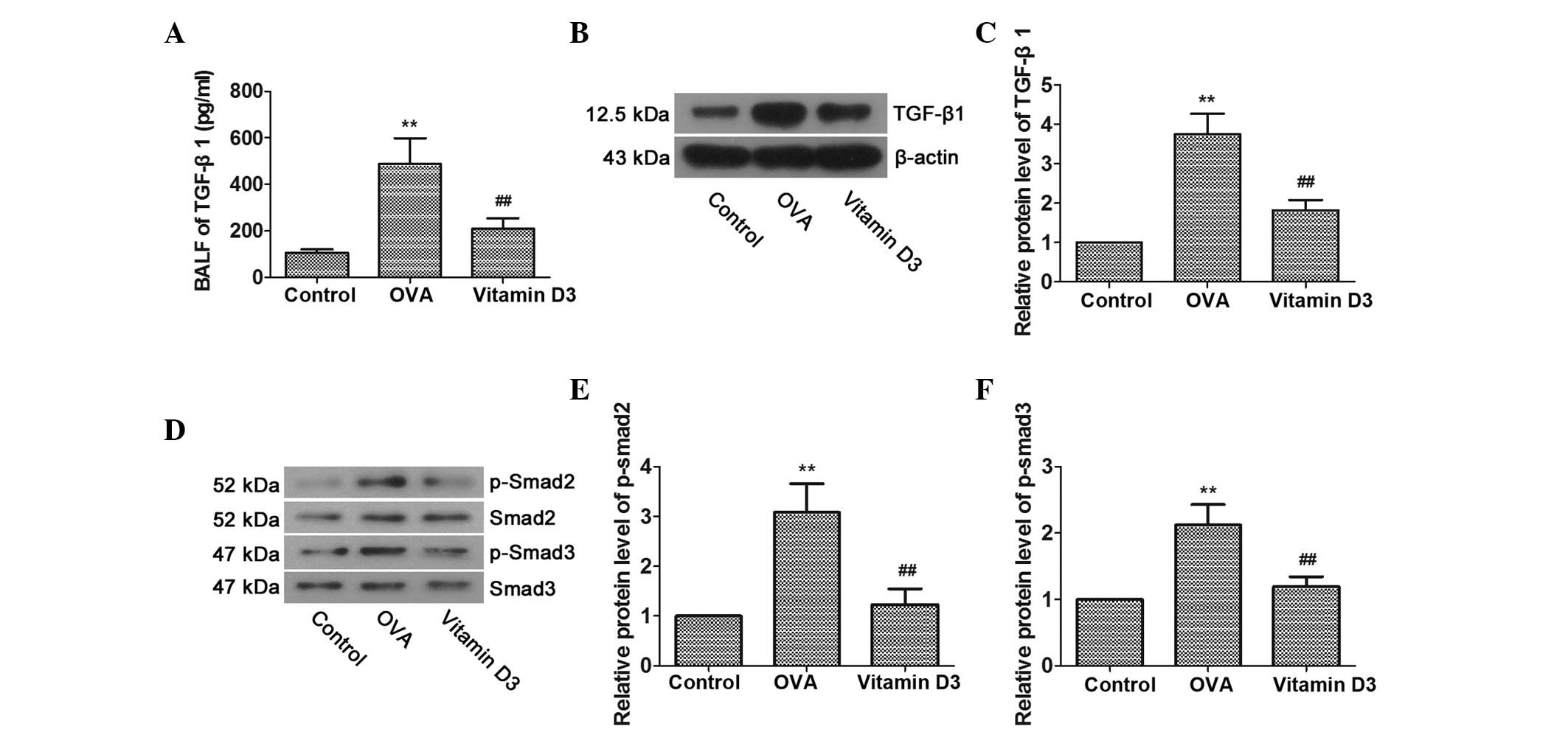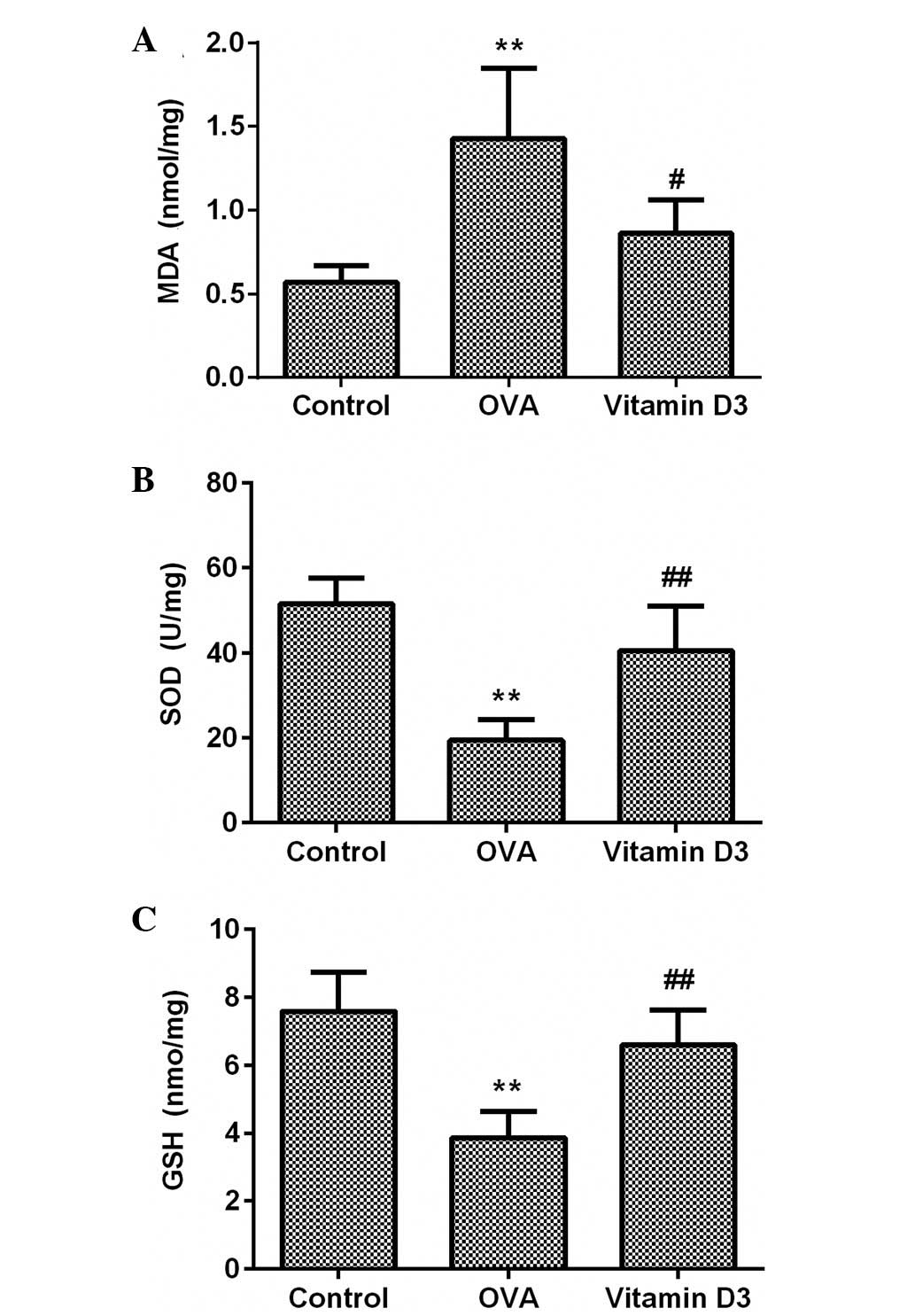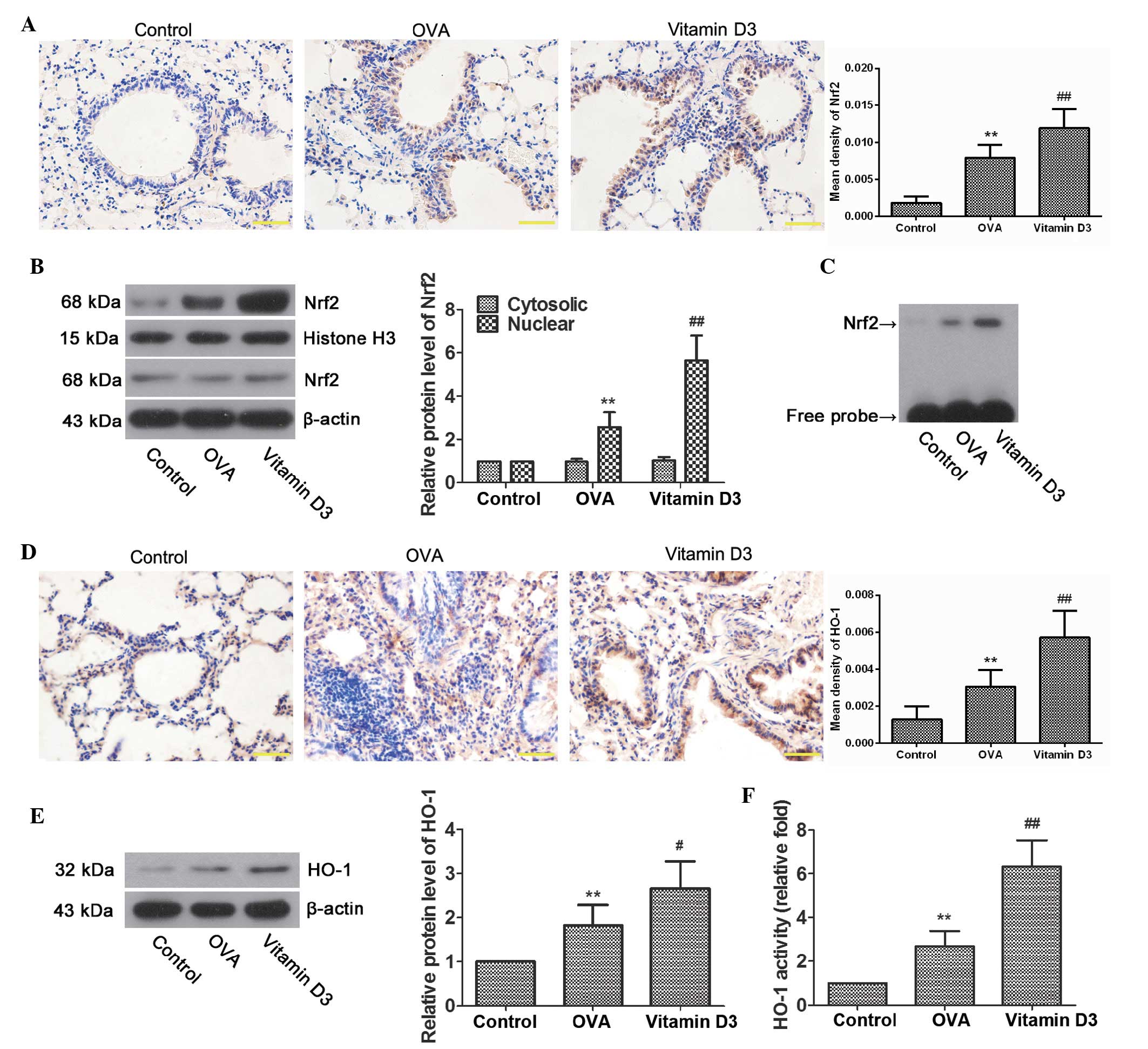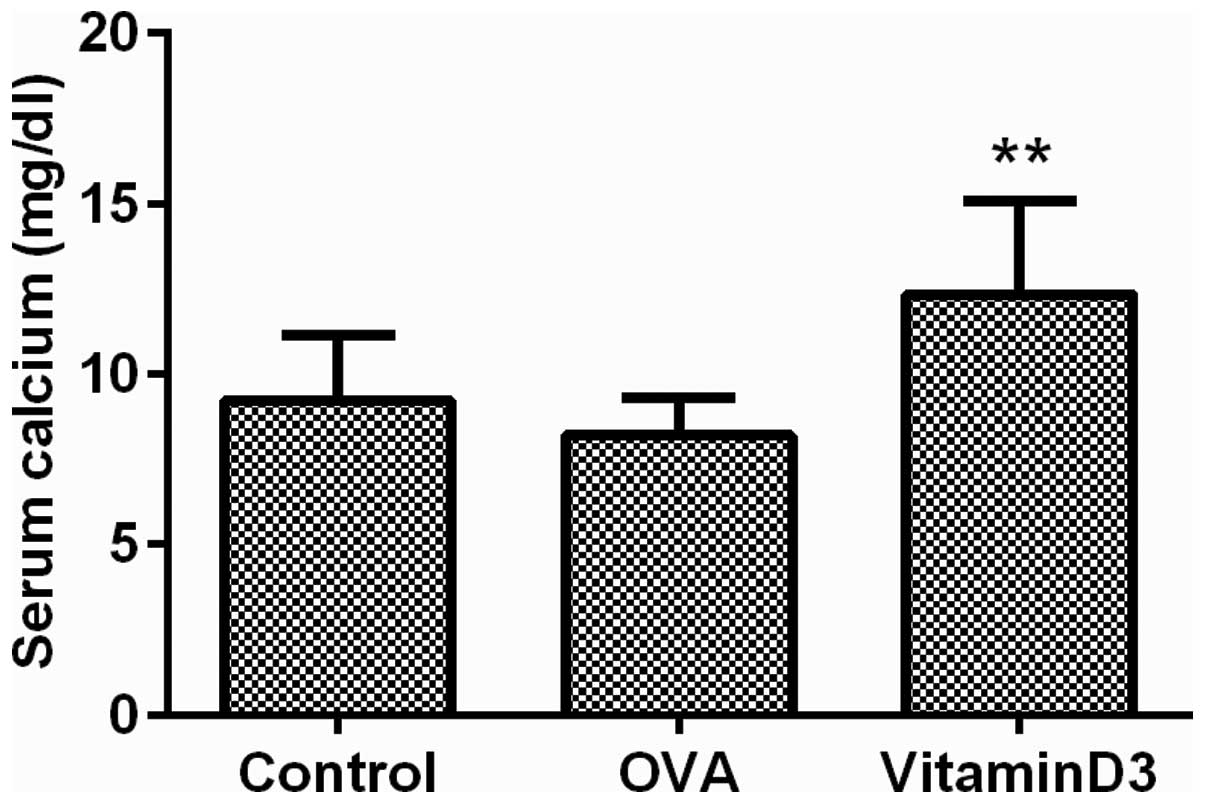|
1
|
Hamid Q and Tulic M: Immunobiology of
asthma. Ann Rev Physiol. 71:489–507. 2009. View Article : Google Scholar
|
|
2
|
Masoli M, Fabian D, Holt S and Beasley R;
Global Initiative for Asthma (GINA) Program: The global burden of
asthma: Executive summary of the GINA dissemination committee
report. Allergy. 59:469–478. 2004. View Article : Google Scholar : PubMed/NCBI
|
|
3
|
Zhou W and Nie X: Afzelin attenuates
asthma phenotypes by downregulation of GATA3 in a murine model of
asthma. Mol Med Rep. 12:71–76. 2015.PubMed/NCBI
|
|
4
|
Barnes PJ: Corticosteroid resistance in
patients with asthma and chronic obstructive pulmonary disease. J
Allergy Clin Immunol. 131:636–645. 2013. View Article : Google Scholar : PubMed/NCBI
|
|
5
|
Dusso AS, Brown AJ and Slatopolsky E:
Vitamin D. Am J Physiol Renal Physiol. 289:F8–F28. 2005. View Article : Google Scholar : PubMed/NCBI
|
|
6
|
Nebel D, Svensson D, Arosenius K, Larsson
E, Jönsson D and Nilsson BO: 1α,25-dihydroxyvitamin D3 promotes
osteogenic activity and downregulates proinflammatory cytokine
expression in human periodontal ligament cells. J Periodontal Res
Dec. 12:2014.Epub ahead of print.
|
|
7
|
Kelsey L, Katoch P, Ray A, Mitra S,
Chakraborty S, Lin MF and Mehta PP: Vitamin D3 regulates the
formation and degradation of gap junctions in androgen-responsive
human prostate cancer cells. PloS One. 9:e1064372014. View Article : Google Scholar : PubMed/NCBI
|
|
8
|
Robsahm TE, Tretli S, Dahlback A and Moan
J: Vitamin D3 from sunlight may improve the prognosis of breast-,
colon- and prostate cancer (Norway). Cancer Causes Control.
15:149–158. 2004. View Article : Google Scholar : PubMed/NCBI
|
|
9
|
Pálmer HG, González-Sancho JM, Espada J,
Berciano MT, Puig I, Baulida J, Quintanilla M, Cano A, de Herreros
AG, Lafarga M and Muñoz A: Vitamin D(3) promotes the
differentiation of colon carcinoma cells by the induction of
E-cadherin and the inhibition of beta-catenin signaling. J Cell
Biol. 154:369–387. 2001. View Article : Google Scholar : PubMed/NCBI
|
|
10
|
Wang TT, Nestel FP, Bourdeau V, Nagai Y,
Wang Q, Liao J, Tavera-Mendoza L, Lin R, Hanrahan JW, Mader S and
White JH: Cutting edge: 1,25-dihydroxyvitamin D3 is a direct
inducer of antimicrobial peptide gene expression. J Immunol.
173:2909–2912. 2004. View Article : Google Scholar : PubMed/NCBI
|
|
11
|
Penna G and Adorini L: 1
Alpha,25-dihydroxyvitamin D3 inhibits differentiation, maturation,
activation, and survival of dendritic cells leading to impaired
alloreactive T cell activation. J Immunol. 164:2405–2411. 2000.
View Article : Google Scholar : PubMed/NCBI
|
|
12
|
Chen S, Sims GP, Chen XX, Gu YY, Chen S
and Lipsky PE: Modulatory effects of 1,25-dihydroxyvitamin D3 on
human B cell differentiation. J Immunol. 179:1634–1647. 2007.
View Article : Google Scholar : PubMed/NCBI
|
|
13
|
Rigo I, McMahon L, Dhawan P, Christakos S,
Yim S, Ryan LK and Diamond G: Induction of triggering receptor
expressed on myeloid cells (TREM-1) in airway epithelial cells by
1,25(OH) vitamin D3. Innate Immun. 18:250–257. 2012.
View Article : Google Scholar
|
|
14
|
Gorman S, Tan DH, Lambert MJ, Scott NM,
Judge MA and Hart PH: Vitamin D(3) deficiency enhances
allergen-induced lymphocyte responses in a mouse model of allergic
airway disease. Pediatr Allergy Immunol. 23:83–87. 2012. View Article : Google Scholar : PubMed/NCBI
|
|
15
|
Lai G, Wu C, Hong J and Song Y:
1,25-Dihydroxyvitamin D(3) (1,25-(OH)(2)D(3)) attenuates airway
remodeling in a murine model of chronic asthma. J Asthma.
50:133–140. 2013. View Article : Google Scholar
|
|
16
|
Zhou Y, Zhou X and Wang X:
1,25-Dihydroxyvitamin D3 prevented allergic asthma in a rat model
by suppressing the expression of inducible nitric oxide synthase.
Allergy Asthma Proc. 29:258–267. 2008. View Article : Google Scholar : PubMed/NCBI
|
|
17
|
Terawaki K, Yokomizo T, Nagase T, Toda A,
Taniguchi M, Hashizume K, Yagi T and Shimizu T: Absence of
leukotriene B4 receptor 1 confers resistance to airway
hyperresponsiveness and Th2-type immune responses. J Immunol.
175:4217–4225. 2005. View Article : Google Scholar : PubMed/NCBI
|
|
18
|
Le AV, Cho JY, Miller M, McElwain S,
Golgotiu K and Broide DH: Inhibition of allergen-induced airway
remodeling in Smad 3-deficient mice. J Immunol. 178:7310–7316.
2007. View Article : Google Scholar : PubMed/NCBI
|
|
19
|
Yao P, Nussler A, Liu L, Hao L, Song F,
Schirmeier A and Nussler N: Quercetin protects human hepatocytes
from ethanol-derived oxidative stress by inducing heme oxygenase-1
via the MAPK/Nrf2 pathways. J Hepatol. 47:253–261. 2007. View Article : Google Scholar : PubMed/NCBI
|
|
20
|
Halwani R, Al-Muhsen S, Al-Jahdali H and
Hamid Q: Role of transforming growth factor-β in airway remodeling
in asthma. Am J Respir Cell Mol Biol. 44:127–133. 2011. View Article : Google Scholar
|
|
21
|
Li MO, Wan YY, Sanjabi S, Robertson AK and
Flavell RA: Transforming growth factor-beta regulation of immune
responses. Ann Rev Immunol. 24:99–146. 2006. View Article : Google Scholar
|
|
22
|
Ryter SW, Alam J and Choi AM: Heme
oxygenase-1/carbon monoxide: From basic science to therapeutic
applications. Physiol Rev. 86:583–650. 2006. View Article : Google Scholar : PubMed/NCBI
|
|
23
|
Kaspar JW, Niture SK and Jaiswal AK: Nrf2:
INrf2 (Keap1) signaling in oxidative stress. Free Radic Biol Med.
47:1304–1309. 2009. View Article : Google Scholar : PubMed/NCBI
|
|
24
|
Zella JB, McCary LC and DeLuca HF: Oral
administration of 1,25-dihydroxyvitamin D3 completely protects NOD
mice from insulin-dependent diabetes mellitus. Arch Biochem
Biophys. 417:77–80. 2003. View Article : Google Scholar : PubMed/NCBI
|
|
25
|
Litonjua AA and Weiss ST: Is vitamin D
deficiency to blame for the asthma epidemic? J Allergy Clin
Immunol. 120:1031–1035. 2007. View Article : Google Scholar : PubMed/NCBI
|
|
26
|
Wittke A, Weaver V, Mahon BD, August A and
Cantorna MT: Vitamin D receptor-deficient mice fail to develop
experimental allergic asthma. J Immunol. 173:3432–3436. 2004.
View Article : Google Scholar : PubMed/NCBI
|
|
27
|
Rodrigo GJ, Rodrigo C and Hall JB: Acute
asthma in adults: A review. Chest. 125:1081–1102. 2004. View Article : Google Scholar : PubMed/NCBI
|
|
28
|
Holgate ST: What does inflammation and
airway remodelling mean? Clinical & Experimental Allergy
Reviews. 1:59–61. 2001. View Article : Google Scholar
|
|
29
|
Fahy JV: Remodeling of the airway
epithelium in asthma. Am J Respir Crit Care Med. 164:S46–S51. 2001.
View Article : Google Scholar : PubMed/NCBI
|
|
30
|
Makinde T, Murphy RF and Agrawal DK: The
regulatory role of TGF-beta in airway remodeling in asthma. Immunol
Cell Biol. 85:348–356. 2007. View Article : Google Scholar : PubMed/NCBI
|
|
31
|
Sagara H, Okada T, Okumura K, Ogawa H, Ra
C, Fukuda T and Nakao A: Activation of TGF-beta/Smad2 signaling is
associated with airway remodeling in asthma. J Allergy Clin
Immunol. 110:249–254. 2002. View Article : Google Scholar : PubMed/NCBI
|
|
32
|
Riedl MA and Nel AE: Importance of
oxidative stress in the pathogenesis and treatment of asthma. Curr
Opin Allergy Clin Immunol. 8:49–56. 2008. View Article : Google Scholar : PubMed/NCBI
|
|
33
|
Andreadis AA, Hazen SL, Comhair SA and
Erzurum SC: Oxidative and nitrosative events in asthma. Free Radic
Biol Med. 35:213–225. 2003. View Article : Google Scholar : PubMed/NCBI
|
|
34
|
Bao BY, Ting HJ, Hsu JW and Lee YF:
Protective role of 1 alpha, 25-dihydroxyvitamin D3 against
oxidative stress in nonmalignant human prostate epithelial cells.
Int J Cancer. 122:2699–2706. 2008. View Article : Google Scholar : PubMed/NCBI
|
|
35
|
Hamden K, Carreau S, Jamoussi K, Miladi S,
Lajmi S, Aloulou D, Ayadi F and Elfeki A: 1 Alpha,25
dihydroxyvitamin D3: Therapeutic and preventive effects against
oxidative stress, hepatic, pancreatic and renal injury in
alloxan-induced diabetes in rats. J Nutr Sci Vitaminol (Tokyo).
55:215–222. 2009. View Article : Google Scholar
|
|
36
|
Rangasamy T, Guo J, Mitzner WA, Roman J,
Singh A, Fryer AD, Yamamoto M, Kensler TW, Tuder RM, Georas SN and
Biswal S: Disruption of Nrf2 enhances susceptibility to severe
airway inflammation and asthma in mice. J Exp Med. 202:47–59. 2005.
View Article : Google Scholar : PubMed/NCBI
|
|
37
|
Kim J, Cha YN and Surh YJ: A protective
role of nuclear factor-erythroid 2-related factor-2 (Nrf2) in
inflammatory disorders. Mutat Res. 690:12–23. 2010. View Article : Google Scholar
|
|
38
|
Lim S, Groneberg D, Fischer A, Oates T,
Caramori G, Mattos W, Adcock I, Barnes PJ and Chung KF: Expression
of heme oxygenase isoenzymes 1 and 2 in normal and asthmatic
airways: Effect of inhaled corticosteroids. Am J Respir Crit Care
Med. 162:1912–1918. 2000. View Article : Google Scholar : PubMed/NCBI
|



